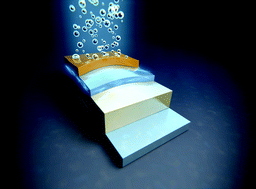Substitution of native silicon oxide by titanium in Ni-coated silicon photoanodes for water splitting solar cells†
Abstract
Using an ultrathin (2 nm) evaporated Ti film to replace the native SiOX of the nSi photoanode and then coating it by thin (2 and 5 nm) Ni layers, the resulting 2 nm Ni/2 nm Ti coated nSi photoanodes (without the native SiOX) reach a photocurrent onset potential of −42 mV relative to the SCE reference electrode in 1 M KOH under 1 simulated sun illumination (−202 mV relative to the potential for the oxygen evolution reaction). With increasing the thickness of the Ni layer to 5 nm, the 5 nm Ni/2 nm Ti/nSi photoanodes show 50 mV lower onset potential than 5 nm Ni directly coated on native SiOX/nSi photoanodes and exhibit a very stable photoelectrochemical performance, which keep 100% activity (10 mA cm−2 at 0.8 V vs. SCE) for ∼6.5 days. These results can be comparable to those of the typical NiOX coated nSi photoanodes with n–p+ buried homojunctions. Using a Ti layer to replace the native SiOX of the nSi photoanodes increases the conductivity of the sample and helps the charge transfer process. In addition, the interlayer Ti film absorbs the oxygen from nearby layers or from the atmosphere, making the Ti layer partially oxidized. The in situ TiOX layer formed from evaporated Ti has more electron defects than the ALD deposited TiO2, and could be responsible for the improved hole conduction process.


 Please wait while we load your content...
Please wait while we load your content...